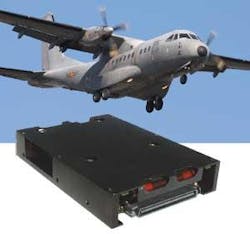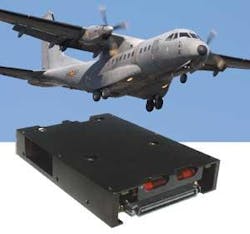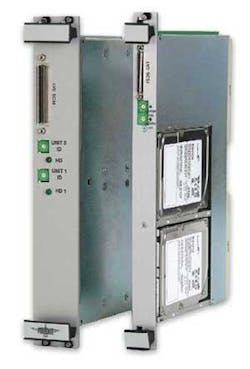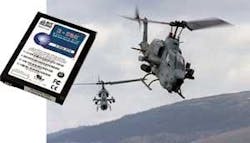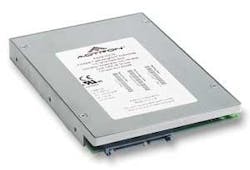Military storage designers call for hard drives
Flash memory is getting cheaper, disk drive growth is slowing, but magnetic media is still the best choice for most military and aerospace recording jobs.
By Ben Ames
Disk drives are still getting denser-slowly-but they easily outstrip solid-state for price and capacity.
“For 15 years, we’ve been playing the game of saying ‘The disk’s going away and solid state will replace it,’ but now we’re in another year and it still hasn’t happened,” says Sam Carswell, chief technology officer of Formation Inc. of Moorestown, N.J.
In fact, engineers continue to improve hard-disk-drive technology. They now pack more data onto each disk, doubling the capacity of hard disk drives over last year. That improves drive performance, not just capacity; with higher storage density, a system interface can read more bits of data with each revolution of the disk.
In the past 12 months, engineers have also produced commercial hard drives that are ruggedized to withstand vibration and shock.
Designers in the consumer automotive industry have quickly adopted them, using hardened 2.5-inch disk drives from producers like Hitachi and Seagate to manage automotive tasks such as MP3 song players, video displays, and navigation.
Military designers often follow consumer innovations, but hardened automotive disks have not worked well in military applications.
“All drives have a leakhole to keep air pressure equal to the outside, but at high temperature and humidity, air moisture goes in, and you get “sticktion”-the drive won’t work at high temperature and it gets ice crystals at cold temperature,” Carswell says.
Some disk manufactures combat that effect by embedding desiccants in the disk material or placing an activated charcoal filter over the leakhole. But those solutions are no match for the constant change of pressure in aircraft, as air rushes in and out of the hole with every takeoff and landing.
Finally, those hardened automotive disks hold just 60 gigabytes, instead of the typical consumer disk capacity of 120 gigabytes in a 2.5-inch disk. That also sacrifices performance, since it takes more revolutions to get a certain amount of data off the disk.
One recent commercial innovation that does work well in military and aerospace applications: serial ATA interface. And military designers are finally requesting the serial ATA interface, after being pushed toward that option for the last two-and-a-half years, he says.
Disks get vertical
Despite this progress, disk manufacturers agree they have taken hard-disk-drive technology about as far as it can go. This does not mean the end of rotating magnetic media. In fact, engineers are already testing the next generation of storage in their labs-vertical recording.
“Magnetic media has long recorded data longitudinally on a disk, arranging little pole magnets like the ones you used to play with in school,” Carswell says. “Those have gotten smaller and shorter, but they are now approaching a barrier of size, so we’re seeing a slowdown from radical disk capacity increases of five years ago.”
The solution is to stand those tiny magnets up on end and driving the magnetic field into the disk, rather than laying it on top.
These new disks will double the capacity of magnetic spinning drives when they are introduced in 2007, and could lead to a tenfold increase within five to seven years.
A storage increase of that magnitude would have a radical influence on military operations.
On a network-centric battlefield covered with sensors and nodes, military platforms must store and communicate enormous amounts of data. Military designers cannot afford to record the entire stream, so they handle the load with data-compression techniques.
This approach has a drawback; every data-compression algorithm shrinks the data by deleting some details. Otherwise, technicians in a lab could gain extra intelligence by studying raw data feeds directly from a camera.
“Take a raw video stream and compress it with any technology-like MPEG-4-and you’ll get a tenfold decrease in detail. So with this new technology, military sensors could record the original, raw data stream, in a noncompressed environment,” he says.
In the meantime, Formation engineers continue to pick the best disk from the market for each new customer, ruggedizing the hardware to fit the application.
In July, engineers at Lockheed Martin chose Formation’s ToughDisk 3500 rugged hard disk to provide data storage for CN-235 Maritime Patrol Aircraft in support of the U.S. Coast Guard’s Integrated Deepwater System
With 2,000-nautical-mile range and 10-hour flight endurance, the CN-235 will perform surveillance, search-and-rescue, and transport duties suitable for traditional Coast Guard missions as well as homeland security missions. The aircraft will use these 400-gigabyte System Integrated Storage Units to contain all system software and data.
Formation’s ToughDisk TD3500 is a 3.5-inch rugged hard disk designed to be a drop-in COTS replacement for standard low-profile disk drives as large as 100 gigabytes capacity. Using a high-speed SCSI or ATA interface, it is rugged enough to resist the effects of shock, vibration, and temperature extremes, and offers greater storage density than solid state at less than 10 percent of the cost per gigabyte, the company says.
High-speed interface
Designers of airborne data-recording systems are asking for higher-speed platforms than every before.
“Over the last 12 months the speed requirements have increased greatly. One of these systems is operational at 1 gigabyte per second, another at 1.8 gigabytes per second,” says Tom Bohman, vice president of business development for recording products at VMETRO Inc. in Houston.
“We have been asked for a system at 2 gigabytes per second, and to put the 1‑gigabyte-per-second recording system in a package the size of a shoe box. We think we have an approach to achieve that, albeit the shoes are for a very tall basketball player.”
VMETRO engineers tackle these demands with their Vortex data-recording engine, a family of hardware and software that focuses on high-speed streaming, digital-data recording, playback, and analysis. The system is for digital signal analysis from medical scanners and industrial inspection systems to military applications like electronic intelligence (ELINT), communications intelligence (COMINT), signals intelligence (SIGINT), synthetic aperture radar (SAR), multispectral thermal imaging (MTI), and software-defined radio (SDR).
The system is designed to record data at 385 megabytes per second to a Fibre Channel-based storage system. VMETRO designers choose Fibre Channel because it is reliable, with drives at 1.4 million hours mean time between failures (MTBF). In comparison, ATA or IDE storage devices are less reliable, with a published MTBF of 600,000 hours, Bohman says.
Its high-speed serial optical interface means the cabling system is light and long distance-up to 1,000 feet-so the storage can be located independently of the recording engine. In comparison, the SCSI cable is bulky and capable of traveling just a few feet, the company says.
Finally, Fibre Channel is flexible, with designs ranging from JBOD (just a bunch of disks), to RAID (redundant array of independent disks) large and small, to ruggedized rotating drives, to sealed and ruggedized drives, and, ultimately, to solid-state drives.
Flash-based solid-state drives are improving their performance, but are still very expensive per gigabyte compared to rotating media, Bohman says. So VMETRO designers created a sealed and ruggedized package of rotating drives called the SANbric. They kept the package small, while fitting it with enough drives to meet demands for high-speed data recording.
Scientists at NASA’s Jet Propulsion Laboratory in Pasadena, Calif. chose the SANbric for their Uninhabited Aerial Vehicle-Synthetic Aperture Radar (UAV-SAR) program.
Scientists use repeat-pass radar to study the Earth by measuring its surface deformation to millimeter-level accuracy. This permits them to measure changes in land cover, hydrology, agriculture, ice thickness and velocity, archeology, oceanography, and seismic activity.
The UAV-SAR will do this by flying precise flight routes with an L-band, repeat-pass interferometric SAR. NASA will record the results with the SANbric system, installing it for initial testing on a Gulfstream GIII business jet, then moving the system to a UAV for final deployment by the end of 2008.
Airborne storage
In another airborne radar storage application, engineers at Northrop Grumman Corp. needed a data recording and playback system for the radar system being developed for the E-2D Advanced Hawkeye carrier-based maritime patrol aircraft.
When it begins flying in 2011, the E-2D will be U.S. Navy’s next-generation airborne early warning and battle-management system, increasing battlespace awareness, providing theater air missile defense capabilities, improving detection and tracking, and shortening the link between sensor and shooter for more agile response to time-sensitive targets.
Under a $5 million contract awarded in October, Northrop Grumman chose the JazzFiber I/O Module from TEK Microsystems Inc. in Chelmsford, Mass.
“By combining our next-generation JazzFiber module, PowerRACE intelligent I/O controller, and embedded switched fabric interconnect, we were able to tailor our off-the-shelf hardware, software, and FPGA IP to meet all of Northrop’s requirements within aggressive size, weight, and power constraints,” said Andrew Reddig, president and chief technology officer of TEK Microsystems.
“By basing our design on the existing JazzStore family of data-recording solutions, we were able to leverage a huge amount of pre-existing software, hardware and FPGA IP, reducing overall cost and technical risk.”
The JazzStore data-recording and playback system can scale up to several 2-gigabit-per-second Fibre Channel RAID dual inline memory modules. It offers high channel density, with eight Serial Front Panel Data Port (FPDP) channels per 6U slot, and it supports real-time recording and playback using a FAT32 file system, allowing direct workstation access to recorded data files.
Digital data controller speeds storage
Researchers today can fill up a terabyte databank with just a few hours of sensor input. To hold it all, they can buy several 500-gigabyte disk drives off the shelf to construct multiterabyte databases for the biggest jobs.
Storage providers say they believe these customers soon will demand storage in the petabyte range-reaching a thousand terabytes, or a million gigabytes.
Databases in that typically store information on an array of hard disk drives, resorting to solid-state memory only when extreme heat or vibration justifies the extra cost, says Tom Skrobacz, vice president at Conduant Corp. in Longmont, Colo.
To keep up with these demands for recording speed and capacity, leaders at Conduant have released the StreamStor Amazon SATA Disk Controller, featuring more than 400 megabytes per second of sustained performance, more than twice the speed of earlier StreamStor controllers.
The Amazon controller is a full-length, 64-bit, Universal PCI bus board that controls 16 Serial ATA drives on eight buses. It lets users choose and change their own interfaces by plugging in a modular mezzanine daughter card for standards such as FPDP I and II, Channel Link, Fibre Channel, and Star Fabric.
The controller works with a variety of storage media, from standard 2.5- or 3.5-inch disk drives to sealed mechanical, solid-state, and compact flash. For defense applications, it offers security features like data partitioning and quick erase. And it enables the most demanding users to perform simultaneous playback while recording.
The system runs as fast as 400 megabytes per second of sustained recording-double the speed of Conduant’s generation-three product, the StreamStor PCI-816XF2.
Of course, every system has its own bottleneck for ultimate speed. “Recording speeds can be gated by other things than the card: the bus, interface, adjoining cards, sensor, A/D converter, or post-processing,” Skrobacz says.
The most demanding users can combine Amazon units, achieving recording speeds of 800, 1.2, and 1.6 megabytes per second. Applications calling for such extreme capacity could include aggregate streams of data, or video sensors for high-resolution government or scientific cameras, Skrobacz says.
Astronomy applications have some of the highest recording demands in any industry. Conduant users include the National Radio Astronomy Observatory (NRAO) and MIT’s Haystack Observatory. Several years ago, MIT researchers installed a Conduant system running at 1 gigabit per second, and they want to upgrade by 2006 to 2 gigabits per second (about 250 megabytes per second), he says.
Other high-intensity applications for data collection include radio astronomy, radar/sonar gathering, digital signal processing, GPS downloads, high-resolution imaging, digital cinematography, and atmospheric applications.
Rugged flash gains capacity
In the past 12 months, engineers in the storage industry have been shrinking solid-state memory chips to fit more data in smaller spaces. At the same time, their customers in the military and aerospace industries are demanding better reliability, with longer mean time between failures (MTBF).
One answer to both challenges could come from rotating magnetic media instead of solid state, as companies are perfecting designs with perpendicular recording, says Joanne de Peralta of BiTMICRO Networks Inc. in Fremont, Calif.
When it is ready for the market, that new technology will boost capacity in servers, PCs, notebooks, and portable devices by standing magnetic fields upright instead of flat on the surface of a hard disk drive.
In the meantime, BiTMICRO is meeting demands with its E-Disk family of rugged data recording devices with FlashBus high-speed data transaction technology. BiTMICRO develops flash disk, solid-state disk (SSD), network storage, and file cache solid-state storage solutions in 2.5- and 3.5-inch hard-disk-drive footprint, 3U and 6U board, and 19-inch rackmount configurations.
E-Disk storage solutions come with SCSI, IDE/ATA, Fibre Channel, and VME interfaces in 2.5-inch and 3.5-inch hard-disk-drive footprints, 6U board, and 19-inch rack-mount configurations scalable up to several terabytes of pure solid-state storage.
The Solid-State Flash-based E-Disk is designed as a direct drop-in replacement for conventional rotating media such as hard disks and tape drives that are not only prone to short production life, but often fail in mobile computing and industrial environments where temperature fluctuations, shock, vibration, dust, moisture, or magnetic fields are present, company officials say.
It also meets national security and defense requirements for data sanitization with securErase data-security feature, and PowerGuard trigger to activate it automatically within six hours of losing power to the disk.
Most recently, BiTMICRO released in September a military-grade version of the E-Disk 3S320, the world’s first Ultra320 SCSI solid-state flash storage.
Designed for extreme environmental conditions, the E-Disk Ultra320 SCSI can operate from -60 to 95 degrees Celsius, and is designed to handle operating shock as strong as 1500 Gs in scientific missions and reconnaissance flights where data recording is critical. This solid state, nonvolatile drive has a sustained read/write rate of 44 megabytes per second. Available in a 3.5-inch form factor, its maximum capacity is 155 gigabytes.
More SCSI storage
A similar new product is the Ultra320 SCSI VME Module, introduced in August by Phoenix International in Orange, Calif.
Billed as the industry’s first plug-in VME storage module with speed of 320 megabytes per second, the unit is also available in a two-slot model, with capacity as large as 600 gigabytes.
This rugged VME storage module is designed for high-speed data acquisition, high-definition imagery, telemetry recording, and data-mirroring applications. The single-slot model can be configured with as many as two each 73-gigabyte, 10,000 RPM hard disks; and the two slot model can hold up to two each 300-gigabyte, 10,000 RPM hard disks.
It offers reliability to 1.4-million-hours mean time between failures, with rugged packaging for shock and vibration. It has transparency to any operating system, and offers front panel and/or back plane SCSI connection.
Solid-state storage gets denser
Manufacturers are shrinking the geometry of circuit die sizes to boost memory density in solid-state flash chips. Companies like Adtron in Phoenix offer 128 gigabytes in a 3.5-inch form factor drive with either IDE or SCSI interface. By the first quarter of 2006, they plan to double that capacity to 256 gigabytes.
“People are buying that product for defense applications on both aircraft and ground vehicles, not just for flight controls, but also for mapping and target acquisition,” says Alan Fitzgerald, Adtron’s president and chief technology officer.
Those users will soon be asking for capacities as high as 1 terabyte, to enable fast data sharing in the net-centric battlespace, where communication flows among aircraft, ships, ground vehicles, and foot soldiers.
Adtron provides this with ArrayPro, a memory management system that enables 80 megabytes per second sustained transfer rates with a 3.5-inch Serial ATA flash disk. ArrayPro is interface-agnostic, so it can also handle common standards like IDE and SCSI, as well as emerging ones like USB, RS422, and RS429.
Flash storage still costs more than hard disk drives, but prices continue to fall as industry demand allows large-volume production.
“With the price of flash coming down, it still clobbers you, but with a smaller stick,” Fitzgerald says. Flash prices fell about 35 percent in 2005, and will fall another 25 percent in 2006, he predicted. “It’s not byte-for-byte less expensive, but it brings better security and reliability.”
To prevent sensitive data from falling into enemy hands, military personnel sometimes have to quickly erase their databanks. In extreme cases like North Korea’s capture of the Navy’s USS Pueblo in 1968 or China’s capture of a Navy P‑3 Orion maritime patrol aircraft in 2001, they sometimes resort to shattering the disks with a hammer or a handgun.
The latest tools are more effective. The National Security Agency requires a storage medium to be overwritten with random data at least three times to ensure all remnants of valuable data are gone.
Adtron’s EraSure technology can sanitize a 128-gigabyte flash disk in 18 minutes, much faster than a 12-hour process for a hard disk drive of that size, he says. The company’s Zap technology takes just one second to intentionally damage the chip with a strong electric charge so it can never be used again.
Some customers in the commercial market have adopted this approach to protect data on their laptops, setting the charge to deploy automatically if a stranger enters the wrong password, for instance.
Customers will always demand greater capacity, so some companies are working feverishly to create alternatives to the current NAND standard in flash technology.
“By the end of 2006 or early 2007, some new technology will become commercially available,” Fitzgerald says. “The new medium could be three-dimensional holographic storage or some other technique, but it will definitely be nonvolatile. The alternative-DRAM or SRAM solid-state storage, which drops its memory when the power turns off-is unpalatable to our customers. That is because once such a product accepts data on the front end, it will be at risk until they flush the cache to flash memory, unless they use a battery or supercapacitor.”
All storage providers face three main technology challenges in coming years: this technology change to a new medium, the drive to meet the European Union’s ROHS lead standards, and the packaging challenge of trying to fit a terabyte of memory into a 3.5-inch form factor.
Push for flash memory
Recent technology changes are pushing solid-state storage from expensive, rugged applications to affordable, consumer electronics platforms.
“Apple eschewing even a small rotating hard drive for NAND flash is a watershed for evolution of solid-state storage. For a desktop PC or media center, you do need hundreds of gigabytes, but for mobility, people will trade capacity for robustness and reliability,” says Gary Drossel, director of product marketing for SiliconSystems of Aliso Viejo, Calif.
Designers must trade low cost for high reliability to satisfy market demand in networking and telecom, interactive kiosks, medical, industrial (automation/robotics), and military applications.
In fact, the consumer electronics market uses a different type of flash technology. To boost high capacity and low cost, it uses multilevel cell flash from manufacturers like Toshiba, sold in retail outlets from BestBuy to Wal-Mart. Military and industrial products use single-level cell flash, which delivers greater reliability at higher cost.
Military designers also demand features like secure erase and data sanitization.
“M-Systems and BiTMICRO do that very well, but it takes power consumption of 2.5 to 3 watts,” Drossel says. “Our SiSweep and SiPurge technology-in any form factor-can erase a 2 gigabyte drive in less than five seconds with 0.2 watt.”
The company’s SiliconDrive technology can run in any form factor, so a 2.5-inch drive uses the same memory technology as CF or module or Type2 PC card. It is available today in sizes as large as 16 gigabytes, and by the first quarter of 2006, will use the new Samsung NAND flash to deliver 32 gigabytes in a Type2 PC card form factor.
To meet demands for the high capacity necessary for military tasks such as a mission data recorder, SiliconSystems engineers take a modular approach. They combine 16, 24, or 32 memory units, networked to achieve 40-, 60-, or 80-megabyte-per-second range collectively.
Engineers traditionally pick hard disk drives with 16 to 128 gigabyte storage to get the write-speed and capacity for jobs with streaming audio or video, but solid-state storage can achieve many of the same jobs with transactional, or small-file transfers, moving its data in many small moves, not in bulk.
“How many gigabytes of your hard drive are you actually using? Windows XP uses 1.2 gigabytes right there, but you don’t always need 16 or 24 or 32 gigabytes, especially if you’re running a compact OS like VxWorks or XP embedded,” Drossel says. “Our solution works great if you’re just managing GPS coordinates, database applications, collect limited telemetry, not downloading high-resolution maps.”
That is the approach they will use when they begin production in November for a wearable computer in a Department of Defense subcontract, Drossel says.
SiliconSystems will supply SiliconDrive units as storage to hold tactical data in wearable computers that soldiers will use in the field for weapons coordination and communication with a command center.
Each soldier will use a wearable computer tied to his weapon, while commanders monitor them from headquarters with a tablet PC. Those units will use SiliconDrive disks packaged in PC card and CF form factors, instead of the usual 2.5-inch shape. For data security, the command center will use SiPurge technology, for nonrecoverable data erasure.
Pentagon planners first tried this approach with wearable computers as a field test with a platoon; this job will be for a larger command group.
Flash memory in the field
Designers at Lockheed Martin needed data storage to calibrate sensors in the Hawkeye “Target Sight System” (TSS) for the U.S. Marine Corps’ AH-1Z Cobra attack helicopter. TSS is an electro-optic infrared sensor system designed to provide enhanced target detection, recognition, and identification at extremely long ranges during day or night operations.
Subcontractor VMETRO in Houston provided a solution with the MDR-520, its rugged, high-performance, data recorder available for FPDP, FPDP II, and Serial FPDP sensor systems, with sustained data recording performance of 240 megabytes per second.
To keep up with the recording speed, capacity, and ruggedness of the MDR-520, VMETRO chose BiTMICRO Networks’ E-Disk Fibre Channel, nonvolatile flash, solid-state disk. They employed two units of 24-gigabyte, 3.5-inch E-Disk Fibre Channel with Embedded PowerGuard, for a total of 48 gigabytes of nonvolatile solid-state storage.
In another application, scientists at the National Aeronautics and Space Administration (NASA) needed data storage for a high altitude balloon to measure cosmic rays in their Cosmic Rays Energetics and Mass (CREAM) project. They chose a 43-gigabyte E-Disk flash disk drive from BiTMICRO.
Led by researchers at the University of Maryland, they used an unmanned helium balloon as the cheapest way to hoist a two-ton payload to a height of about 125,000 feet. Launched from the National Science Foundation’s McMurdo Station in Antarctica in December 2004, the 4,055-pound polyethylene balloon made three orbits around the South Pole over a period of 42 days, recording 36 gigabytes of data.
null
